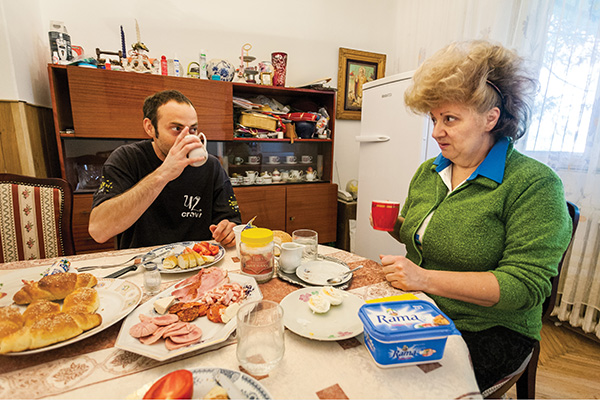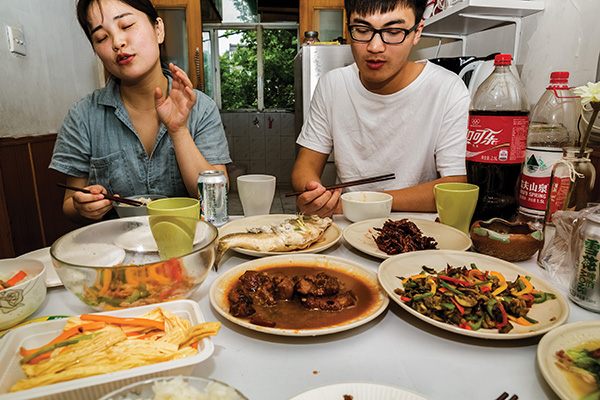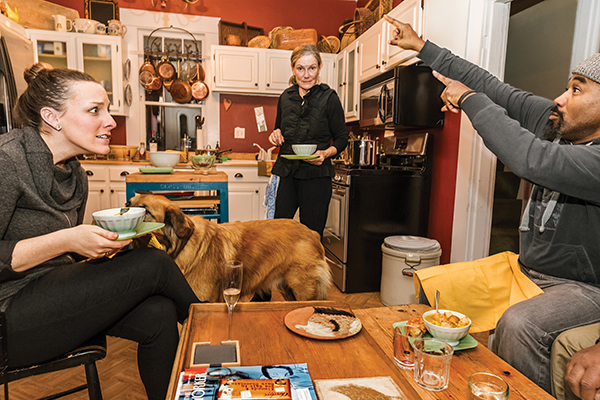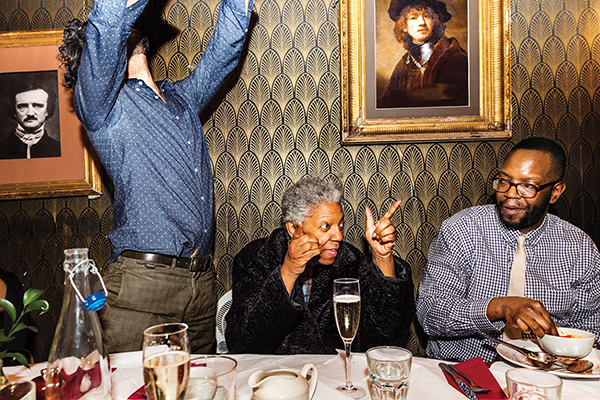At table
Like most of us, I was taught not to talk with my mouth full. Yet the dinner table is a space where words often flow freely. It is also a place where images abound. When mouths are full and half-eaten food is spread about, still life takes form, portraits congeal and “tablescapes” emerge from the stuff of everyday life.
Since 2005, I have been using the messy contingency of plates and bottles and tableware to record the human relationships taking place before my camera. My series At Table has unfolded in dining rooms, kitchens, restaurants and bars around the world, forming a very personal visual anthropology of expression and connection where I am also an active participant in the drama, revelry or domestic action that ensues when food and drink are served.
At times, I am a special guest, at others an invited photographer. In most cases, I am just another face at the table. To my own family and friends, I am often an annoyance — the gadfly who provokes with pictures rather than words. While my own meal often goes cold, I try to connect with the moment. My on-camera flash is intended to fade into a background meant to foreground the relationships it reveals.

In Serbia, I witness a mother and son disagreeing about daily events over an impressive Balkan breakfast spread. In China, I enjoy a meal my students carefully prepared while we discuss contemporary art and daily gossip. In Dayton, the family dog disrupts an animated moment among the Benkendorf family members and local artist James Pate. In my own childhood home, my mom and grandma compete for family rummy tile fame as a bottle of white zinfandel disappears. Across the border in Mexico, a family celebrates its beloved matriarch as colorful packages frame what some see as a melancholy moment. This woman’s grandson, Tomás, eventually came to Dayton to live with my own family during his gap year. I am an only child, and Tomás’ story highlights the way in which At Table has come to serve as a kind of surrogate family archive. My childhood daydreams often envisioned an ever-growing family reunion photograph — a picture peopled with an endless congregation of others who didn’t necessarily look or live like me. After the lessons of this long-term art project, I now know that At Table is partly a manifestation of that naïve but far-reaching dream.

While not all subjects grant me permission to use their likenesses, most participants have come to appreciate the imagery. After all, by pressing pause on a scene, these photos offer them access to otherwise inaccessible memories. Photography has long been both celebrated and reviled for its ability to preserve times we may not otherwise see or remember. In At Table, what we see are generally spaces of abundance. I recognize that this access to sustenance and togetherness is not a universal condition.
During the past five years, I have become active in local efforts to raise awareness of food insecurity and promote food justice. While At Table does not represent hunger, it does often serve as a backdrop for conversations around this issue. In 2014, professor Ruth Thompson-Miller and I chose to use food as a means to address issues such as race and immigration for the University’s first course on Art as Social Practice. Since then, I have partnered with a number of individuals
and organizations, including Gem City Market, Hall Hunger Initiative, Welcome Dayton and The Foodbank, to produce Dinner in the Desert Kitchen, an annual student-organized event of art and conversation around food and social equity. Using a cross-disciplinary lens, we look closely at realities like redlining and gentrification to better understand how our local histories play into national and global trends that presently affect our own neighbors and communities.

While most artists can’t claim to be social scientists, we are often effective instigators. I love and rely on academia, but I don’t do so well with rules. I battle with the role and category of photographer as often as I grapple with disciplinary silos. I am not a photojournalist, nor am I a traditional documentary photographer. These photographs reflect a tension between fact and fiction, serving as imperfect memories in their carefully edited selection. Yet they can also function as shared artifacts and documents of people, products and cultures convening at common ground: at the table, all disciplines converge.
Since I joined the faculty in 2011, the University of Dayton has offered me the opportunity to transcend disciplinary boundaries in my work as an artist and an advocate for social change. UD has provided the chance to work with a range of academic and community doers and thinkers whom I love and admire. As At Table enters its final year of production, I look forward to the future tables I will visit with some of these people — in Kentucky with The Moral Courage Project, Berlin with UD’s sustainability program, and Prague, a city where I once lived and in which I look forward to reuniting with Czech dumplings, local pilsner and former students. As I wrap up over a decade of eating, drinking and documenting, I celebrate the awkward beauty and chaotic authenticity the At Table series has collected.

I am also reminded that the work is not intended to flatter. People often compare the style of At Table to artists like Martin Parr, whose humor-tinged realist photographs (which I love) are perhaps more critical of their subjects. My own project intends no such criticism. As one visitor to the Dutoit Gallery on Front Street in Dayton recently put it, “I didn’t get the photos at first; I thought you might be making fun of these people. But then I realized you really just like them a lot. I mean you really, really like these people!” He got that right. I hope you will, too.
Glenna Jennings is an associate professor in the Department of Art and Design. She is a recipient of several Ohio Arts Council Individual Excellence awards and a Robert Rauschenberg Foundation residency award. She will present a solo exhibition of At Table at Blue Sky Gallery in Portland, Oregon, in December 2020.